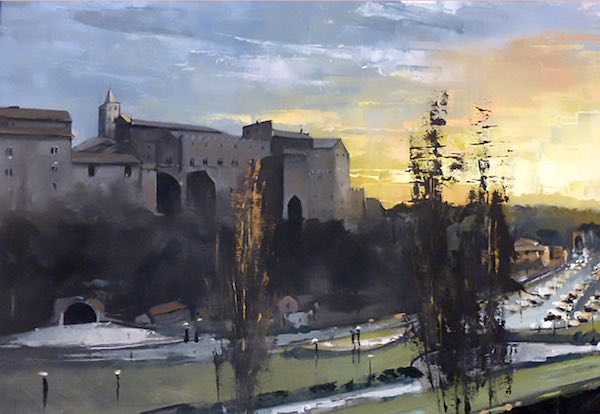

Throughout her extensive career, the Irish-American writer Mary Jane Cryan has focused upon la Tuscia, that area north of Rome whose name has come down to us from the pre-Roman area of Etruria, dating from the ninth century BC. A resident of Vetralla, in the very heart of the ancient Etruscan civilization, Cryan is an historian, publisher, cruise ship lecturer, and the author of seven books, beginning with Affreschi Exploring Etruria published in 2001.
Among her books which celebrate the area are Etruria, storie e segreti (2019), in Italian, and The Painted Palazzo (2017), available in a bilingual Italian-English edition. For gourmet fun there is also Olio e Ricordi in Cucina (2009), a cookbook by her partner Fulvio Ferri dedicated to local cuisine (in Italian with a brief summary in English by Cryan). Her prize-winning website is www.elegantetruria.com.
Her town of Vetralla, which stands on a strip of high ground overlooking the Via Cassia on one side and a huge valley on the other, is a treasure house of 16th and 17th century palazzi. Its Gothic Church of San Francesco, with cosmatesque floors, was built atop the foundations of a church dating from the 7th century. The town’s lively culture today includes a year-round series of world-class concerts organized by Susanna Ohtonen and Ruud Hupperts called Opera Extraviganza.
Vetralla was a major stopover on the route that since the Middle Ages brought pilgrims from North Europe to Rome. Called the Via Francigena (i.e., “the road from France”), the pilgrims actually walked the Via Cassia, the ancient road to Rome. The Cassia is noted today for its heavy auto traffic, and so today’s pilgrims who still walk to Rome from North Europe find byways near that road, but always stop at the ancient Tuscia towns like Viterbo and Sutri as well as Vetralla.
Cryan’s Etruria, storie e segreti (also available as an e-book not only synthesizes local arts and traditions but presents her original research into the myriad foreign visitors in la Tuscia, among them Irish, English, Japanese, Spanish and French. Also passing through en route to Rome, and writing about and painting it, were the authors Nathaniel Hawthorne, Charles Dickens and Johann Wolfgang von Goethe, and the artist Bartolomeo Pinelli. The wealthier might be set upon by brigands who had been hiding in the woodlands; Pinelli has painted this.
Cryan’s bilingual book The Painted Palazzo recounts Vetralla’s foreign visitors, its secret gardens, recent discoveries and, as the title states, the painted palace, which refers to the naif-style interior decorations dating from the 1930s by the renowned artist Olga Canonica-Piatti, on the walls of the piano nobile of the Palazzo Piatti.
Not least, partner Fulvio Ferri’s cookbook Olio e Ricordi in Cucina, offers a wealth of traditional recipes, from acqua cotta to zucchini flower fritters. Home foods include sausages cooked with green grapes, lamb stew with mushrooms, and pork chops with apples. And there are vegetarian dishes as well: fried artichokes, orange salad, wild asparagus in salmi and cardoons in olive oil. Buon appetito!




